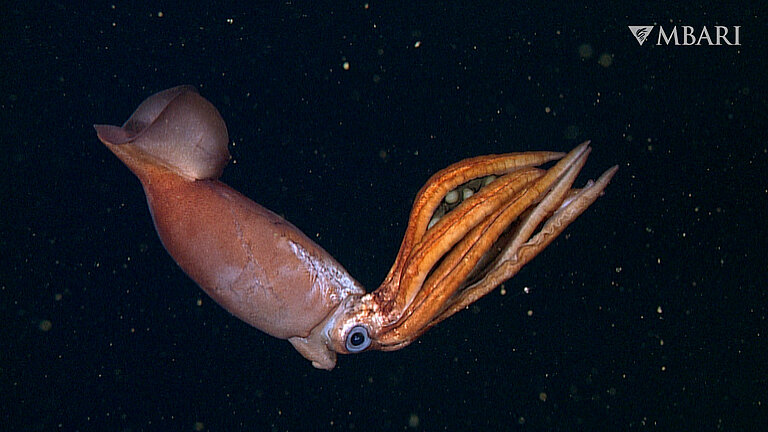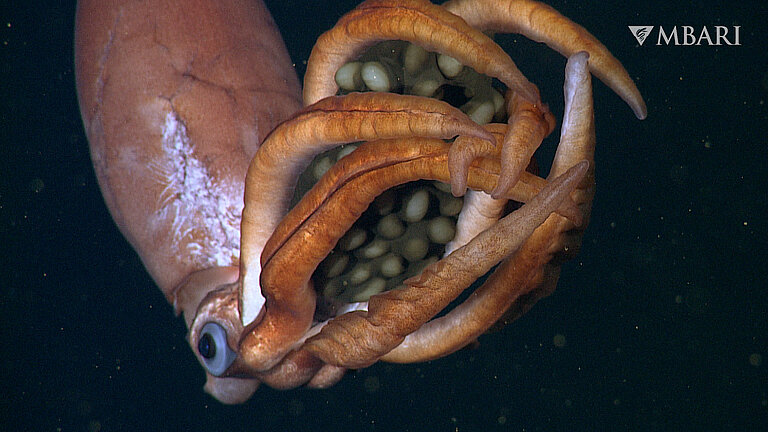Underwater robots discover deep-sea squid that broods giant eggs
During an expedition to the Gulf of California, researchers observed a previously unknown species of squid carrying a cluster of exceptionally large eggs
The deep sea is the largest living space on Earth, but many of the animals and habitats far beneath the ocean’s surface remain shrouded in mystery. MBARI’s advanced underwater robots, including remotely operated vehicles (ROVs), are helping survey life in the ocean’s depths. During an expedition to Mexico’s Gulf of California in 2015, MBARI’s ROV DOC RICKETTS encountered a mother squid cradling a cluster of eggs.
MBARI researchers had previously observed deep-sea squids brooding their eggs, but this sighting was striking because the eggs were twice as large as those of other brooding deep-sea squids.
A team of researchers from GEOMAR Helmholtz Centre for Ocean Research Kiel, MBARI, and the University of South Florida conducted a meticulous review of the ROV footage and examined specimens of similar-looking squids collected on previous expeditions to the Gulf of California. The team has determined this individual likely represents an unknown species of the family of Gonatidae and one that broods giant eggs. Researchers shared their findings in a recent research publication in Ecology.
“Squid play an important role in the ocean — they’re fierce predators and a vital food source for lots of animals, even humans — but we still have a lot to learn about the squid that live in the deep sea. Advanced underwater robots are helping us better understand the lives of deep-water squids, revealing fascinating new information about their biology and behaviour. Each new observation is another piece of the puzzle,” said Henk-Jan Hoving, a previous postdoctoral fellow at MBARI who now leads the deep-sea biology working group at GEOMAR and was the lead author of this new study.
Scientists still have many unanswered questions about the lives of deep-sea squids. For the majority of deep-sea squids, researchers have never observed mature females or their spawned eggs.
While maternal care is common among octopuses, brooding has only been observed in a handful of squids. Most squid species leave clumps of eggs attached to the seafloor or release neutrally buoyant egg masses containing thousands of eggs that drift in the water column. These reproductive strategies require relatively low effort compared to providing post-spawning egg care.
“Brooding takes a lot out of a mother squid. She won’t eat while carrying her eggs and ultimately dies after her eggs hatch. But her sacrifice improves the chances that her offspring will survive. It’s just one of the many remarkable adaptations that may help cephalopods to survive in the deep sea,” explained Hoving.
MBARI researchers were the first to observe brooding behavior in a deep-sea squid. Over 37 years of deep-sea exploration, MBARI’s ROVs have recorded 17 observations of brooding squids. These include multiple sightings of brooding by black-eyed squid (Gonatus onyx) and other armhook squids (Gonatus sp.) that are difficult to identifyto species from video alone, as well as the deep-sea squid Bathyteuthis. But the squid observed in the Gulf of California stood out to researchers.
“The deep sea is the largest living space on Earth and there is a lot left to be discovered. Our unexpected encounter with a squid brooding giant eggs caught the attention of everyone in the ship’s control room. This remarkable sighting underscores the diversity of ways that animals adapt to the unique challenges of living in the deep,” said MBARI Senior Scientist Steven Haddock, who was chief scientist during the expedition that encountered this brooding squid.
By analyzing the video footage and studying specimens of similar-looking squids collected on previous expeditions to the Gulf of California, the research team determined this was likely an undescribed species in the family Gonatidae.
It was the large size of this squid’s eggs — approximately 11.6 millimeters (about a half inch) in diameter — that caught the eye of the research team. Previous sightings of brooding Gonatus squids reported eggs half that size, with a maximum diameter of only six millimeters (about a quarter of an inch).
The squid observed in the Gulf of California was also brooding far fewer eggs than other Gonatus squids. Researchers estimated she was carrying 30 to 40 eggs, whereas the Gonatus squids seen in the past were known to brood up to 3,000 eggs at a time.
Producing numerous small eggs is beneficial in environments with limited food and/or high predation. In these environments, a larger number of offspring offers a greater chance of at least a few surviving. Giant eggs may be more beneficial in the more stable and predictable conditions found in the deep sea, allowing for higher investment in fewer offspring that have a better chance of survival. This has been seen in other deep-sea cephalopods, including the warty deep-sea octopus (Graneledone sp.) and the pearl octopus (Muusoctopus robustus).
Extrapolating from data reported by other scientists on egg development rates, the research team estimated that the eggs of this new deep-sea squid may take one to four years to develop, which is longer than the entire life cycle of most shallow-water squids.
Deep-sea squids play a vital role in ocean food webs. They are predators that feast on fishes and invertebrates in the midwater, and in turn, they are eaten by large fishes, sharks, whales, dolphins, seals, and seabirds. Deep-sea squids make up a large part of the diets of commercially important fishes like tunas, swordfish, and billfishes. Despite their ecological and economic importance, we still know very little about the reproductive biology and natural history of deep-sea squids. MBARI scientists and their collaborators are answering fundamental questions about the biology of deep-sea cephalopods.
– Story by MBARI Senior Science Communication and Media Relations Specialist Raúl Nava and Senior Research Technician Kyra Schlining –
Original Publication:
Hoving, H.-J.T., S.H.D. Haddock, B.H. Robison, and B.A. Seibel (2024). Giant eggs in a deep-sea squid. Ecology.
DOI:10.1002/ecy.4319
Funding
Funding for this research was provided by the David and Lucile Packard Foundation and the Deutsche Forschungsgemeinschaft (DFG) under grant HO 5569/2-1 (Emmy Noether Junior Research Group).

A deep-sea squid brooding giant eggs: During an expedition to the Gulf of California in 2015, researchers encountered a squid brooding exceptionally large eggs. New research suggests this may represent a previously unknown species in the family Gonatidae. Image: MBARI

The astonishingly large eggs the squid mother was carrying were almost 12 millimeters (about a half inch) in diameter, roughly twice as large as the eggs previously observed in brooding Gonatus squids. Image: MBARI


